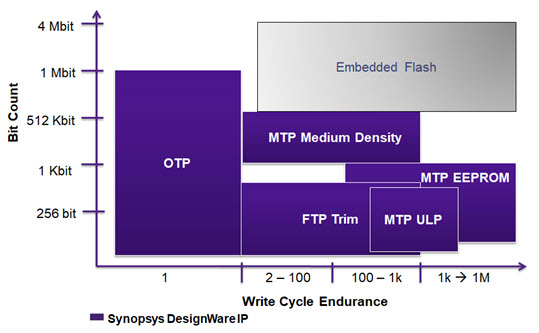Nobody likes drama. Wait, let me narrow that down a bit. Chip designers really hate drama. They live in a world of risk and uncertainty, a world that tool and IP vendors spend considerable resources trying to make safer and more rational. It’s notable just how ironic that Sidense and Kilopass were duking out patent litigation in the earlier part of the decade. Their products, one time programmable (OTP) non-volatile memory (NVM) exist solely to provide certainty and reliability in a wide range of IC’s – both digital and analog, from 180nm down to 16nm. It is noteworthy that both of these companies have been acquired by Synopsys – probably the EDA/IP company most renowned for its no non-sense approach to business and technology.
While usually a diversity of suppliers is a good thing for customers, these acquisitions have probably been for the better. Each of the two, Kilopass and Sidense, had their own strengths in this market, while both using similar 1T and 2T antifuse technology that has a lot to offer. Of course, there is more to OTP NVM than the bit cell, controller circuitry is also responsible for many aspects of the NVM memory block operation.
What are chip designers looking for when evaluating OTP NVM memory? In many cases OTP NVM is used for security related features, such as unique device identity, crypto key or secure boot code storage. It needs to be compact, cost effective, power efficient, secure and reliable. With the consolidation of this technology by Synopsys, customers should expect to have access to a full range of OTP NVM technologies. This ranges from small register size blocks up to megabit size storage for boot code.

Antifuse OTP NVM is easy to use because it requires no additional layers for CMOS processes. This helps manage production costs and risks. Antifuse also has some useful characteristics. Because the programming involves oxide breakdown during the write operation, it is nearly impossible to read the logic state through mechanical or visual inspection. Symmetric storage strategies also eliminate side channel attacks to read data. The oxide breakdown is also non-reversible, so it is not prone to EM driven metal regrowth, like eFuse can experience.
Also unlike the NVM techniques that use stored charge, antifuse NVM are not vulnerable to UV, thermal or aging issues that can lead to charge depletion and associated data loss. Antifuse is a robust and efficient method for OTP NVM. Larger instances can support few time programmable (FTP) which is implemented using remapping in the controller to provide re-write functionality. This is useful for trim information on PMIC, calibration on sensors, re-provisioning of security keys, or limited code updates, etc.
Synopsys, Sidense and Kilopass were all known for the extensive qualification work on a wide range of processes. A lot of sensor and analog chips use antifuse on older legacy process nodes, but Synopsys antifuse has been qualified on the latest FinFET nodes as well. This makes it attractive because other NVM techniques have had trouble migrating to smaller more advanced nodes.
Synopsys DesignWare OTP NVM is ideal for automotive applications because of its AEC-Q100 grade 0, 1, and 2 qualification. It has very high temperature stability, with operating temperatures up to 175C. Synopsys DesignWare OTP NVM is available on TSMC, SMIC, UMC, GLOBALFOUNDRIES.
Synopsys recently added an excellent overview of their full range of OTP NVM offerings and their advantages on their website. Despite the dramatic history, it seems that antifuse OTP NVM is a sound solution when looking for security, safety and optimal PPA.
Share this post via:





Comments
There are no comments yet.
You must register or log in to view/post comments.